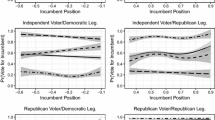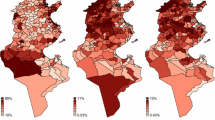Abstract
ADA scores and Nominate scores are used for the first time to examine the influence of spatial voting records on which candidate wins the party’s presidential nomination and on which nominee wins the general election. We find that the most conservative Republican candidate and moderately liberal Democrats were most likely to win their party’s nomination. For general elections we find that the candidate’s spatial record has nearly as much impact on the outcome as economic growth, which has been the focus of most past empirical research. The nominee whose voting record is more moderate is more likely to be elected.
Similar content being viewed by others
References
Abramowitz, A. (1988). Explaining senate election outcomes. American Political Science Review, 82, 385–403.
Adams, J., & Merrill, S. (1999). Modeling party strategies and policy representation in multiparty elections: Why are strategies so extreme? American Journal of Political Science, 43, 765–791.
Adams, J., & Merrill, S. (2000). Spatial models of candidate competition and the 1988 French presidential election: Are presidential candidates vote-maximizers? Journal of Politics, 62, 729–756.
Adams, J., & Merrill, S. (2003a). Voter turnout and candidate strategies in American elections. Journal of Politics, 65, 161–189.
Adams, J., & Merrill, S. (2003b). Candidates’ policy preferences and electoral outcomes: The three faces of policy representation. Unpublished manuscript.
Alvarez, R. M., & Nagler, J. (1995). Economics, issues, and the perot candidacy: Voter choices in the 1992 presidential election. American Journal of Political Science, 39, 714–744.
Alvarez, R. M., & Nagler, J. (1998). Economics, entitlements, and social issues: Voter choices in the 1996 presidential election. American Journal of Political Science, 42, 1349–1363.
Alvarez, R. M., Nagler, J., & Bowler, S. (2000). Issues, economics, and the dynamics of multiparty elections: The 1997 British general election. American Political Science Review, 94, 131–150.
Alvarez, R. M., Nagler, J., & Willette, J. (2000). Measuring the relative impact of issues and the economy in democratic elections. Electoral Studies, 19, 237–253.
Aranson, P. H., & Ordeshook, P. C. (1972). Spatial strategies for sequential elections. In R.G. Niemi, & H.F. Weisberg (Eds.), Probability models of collective decision making (pp. 298–331). Columbus, OH: Charles E. Merrill.
Bartels, L. M., & Zaller, J. (2001). Presidential vote models: A recount. PS: Political Science and Politics, 34, 9–20.
Bullock, C. S., & Brady, D. W. (1983). Party, constituency, and roll-call voting in the U.S. Senate. Legislative Studies Quarterly, 13, 29–43.
Campbell, J. E. (2001). The referendum that didn’t happen: The forecasts of the 2000 presidential election. PS: Political Science and Politics, 34, 33–38.
Coleman, J. S. (1971). Internal processes governing party positions in elections. Public Choice, 11, 35–60.
Coleman, J. S. (1972). The positions of political parties in elections. In R.G. Niemi, & H.F. {Weisberg} (Eds.), Probability models of collective decision making (pp. 332–357). Columbus, OH: Charles E. Merrill.
Congressional Quarterly (1997). Presidential Elections, 1789–1996. Washington, DC: Congressional Quarterly.
Cooper, A., & Munger, M. C. (2000). The (un)predictability of primaries with many candidates: Simulation evidence. Public Choice, 103, 337–355.
Enelow, J. M., & Hinich, M. J. (1984). The spatial theory of voting: An introduction. Cambridge, England: Cambridge University Press.
Erikson, R., & Romero, D. (1990). Candidate equilibrium and the behavioral model of the vote. American Political Science Review, 84, 1103–1126.
Fenno, R. F. (1977). Home style. Boston: Little, Brown.
Figlio, D. (2000). Political shirking, opponent quality, and electoral support. Public Choice, 103, 271–284.
Fiorina, M. (1974). Representatives, roll calls, and constituencies. Lexington, MA: Lexington Books.
Francis, W. L., & Kenny, L. W. (1996). Position shifting in pursuit of higher office. American Journal of Political Science, 40, 768–786.
Francis, W. L., & Kenny, L. W. (2000). Up the political ladder: Career paths in U.S. politics. Thousand Oaks, CA: Sage Publications.
Francis, W. L., Kenny, L. W., Morton, R. B., & Schmidt, A. B. (1994). Retrospective voting and political mobility. American Journal of Political Science, 38, 999–1024.
Glazer, A., & Robbins, M. (1985). How elections matter: A study of U.S. senators. Public Choice, 46, 163–172.
Goff, B. L., & Grier, K. B. (1993). On the (mis)measurement of legislator ideology and shirking. Public Choice, 76, 5–20.
Grofman, B., Griffin, R., & Glazer, A. (1990). Identical geography, different party: A natural experiment on the magnitude of party differences in the U.S. senate 1960–84. In R. J. Johnston, F. M. Shelley, & P. J. Taylor (Eds.), Developments in electoral geography {(pp. 207–217).} London: Routledge.
Groseclose, T., Levitt, S. D., & Snyder, J. M. (1999). Comparing interest group scores across time and chambers: Adjusted ADA scores for the U.S. Congress. American Political Science Review, 93, 33–50.
Hibbs, D. A. (2000). Bread and peace voting in U.S. presidential elections. Public Choice, 104, 149–180.
Holbrook, T. M. (2001). Forecasting with mixed economic signals: A cautionary tale. PS: Political Science and Politics, 34, 39–44.
Huntington, S. (1950). A revised theory of American party politics. American Political Science Review, 44, 669–677.
Jenkins, J. A., & Sala, B. R. (1998). The spatial theory of voting and the presidential election of 1824. American Journal of Political Science, 42, 1157–1179.
Johannes, J. R., & McAdams, J. C. (1981). A congressional incumbency effect: Is it casework, policy compatibility, or something else? American Journal of Political Science, 25, {512–542.
Jung, G., Kenny, L. W., & Lott, J. R. (1994). An explanation for why senators from the same state vote differently so frequently. Journal of Public Economics, 54, 65–96.
Keech, W. (1995). Economic politics: The costs of democracy. Cambridge, England: Cambridge University Press.
Lewis-Beck, M. S., & Tien, C. (2001). Modeling the future: Lessons from the Gore forecast. PS: Political Science and Politics, 34, 21–23.
Norpath, H. (2001). Primary colors: A mixed blessing for Al Gore. PS: Political Science and Politics, 34, 45–48.
Owen, G., & Grofman, B. (2000). Two-stage electoral competition in two-party contests: Persistent divergence of party positions. Unpublished manuscript.
Peltzman, S. (1984). Constituent interest and congressional voting. Journal of Law and Economics, 27, 181–210.
Peltzman, S. (1990). How efficient is the voting market. Journal of Law and Economics, 33, 27–63.
Poole, K. T., & Rosenthal, H. (1984). U.S. presidential elections 1968–80: A spatial analysis. American Journal of Political Science, 28, 282–312.
Poole, K. T., & Rosenthal, H. (1991). Patterns of congressional voting. American Journal of Political Science, 35, 228–278.
Poole, K. T., & Rosenthal, H. (1997). Congress: A political-economic history of roll call voting. Oxford, UK: Oxford University Press.
Schmidt, A. B., Kenny, L. W., & Morton, R. B. (1996). Evidence on electoral accountability in the U.S. Senate: Are unfaithful agents really punished? Economic Inquiry, 34, 545–567.
Shapiro, C. R., Brady, D. W., Brody, R. A., & Ferejohn, J. R. (1990). Linking constituency opinion and senate voting scores: A hybrid explanation. Legislative Studies Quarterly, 17, 599–622.
Stata (2001). Stata Reference Manual, Release 7, Volume 2 H-P. College Station, Texas: Stata Press.
Westlye, M. C. (1991). Senate elections and campaign intensity. Baltimore: Johns Hopkins Press.
Whitby, K. J., & Bledsoe, T. (1986). The impact of policy voting on the electoral fortunes of senate incumbents. Western Political Quarterly, 39, 690–700.
Wright, G. (1989). Policy voting in the U.S. Senate: Who is represented? Legislative Studies Quarterly, 14, 465–486.
Wright, M. B. (1993). Shirking and political support in the U.S. Senate, 1964–84. Public Choice, 76, 103–123.
Zaller, J. R. (1998). Monica Lewinsky’s contribution to political science. PS: Political Science & Politics, 31, 182–189.
Zupan, M. A. (1992). Measuring the ideological preferences of U.S. presidents: A proposed (extremely simple) method. Public Choice, 73, 351–361.
Author information
Authors and Affiliations
Corresponding author
Rights and permissions
About this article
Cite this article
Kenny, L.W., Lotfinia, B. Evidence on the importance of spatial voting models in presidential nominations and elections. Public Choice 123, 439–462 (2005). https://doi.org/10.1007/s11127-005-7170-5
Accepted:
Issue Date:
DOI: https://doi.org/10.1007/s11127-005-7170-5




